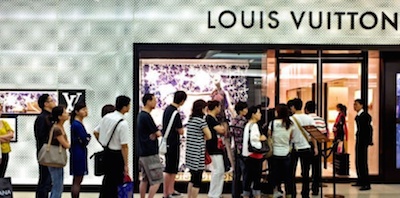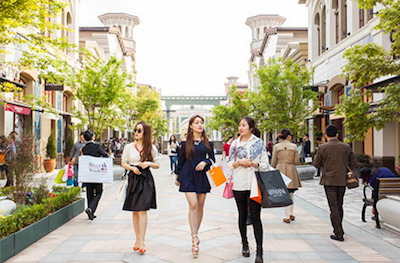 Image courtesy of Peninsula Hotels
Image courtesy of Peninsula Hotels
SEOUL, South Korea – Luxury brands can no longer get away with disparate pricing around the world, according to an analyst from HSBC speaking at the Condé Nast International Luxury Conference.
Before, brands could charge more for the same product in certain countries, including China, but with a rise in ecommerce more transparency is expected and required. In a keynote on April 20, Erwan Rambourg, global head of consumer and retail research at HSBC and author of the Bling Dynasty, laid out the key benefits and impacts price harmonization may have on luxury brands.
Dominating force
One likely outcome of leveled pricing is a drastic reduction in daigou, or the practice of buying luxury goods for others while on vacation. This may mean that Louis Vuitton or Prada will no longer have long lines of tourists outside their stores in Paris or Milan, since the traffic will be limited to personal clients of the brand.
 Tourists lined up outside Louis Vuitton
What this also means for luxury brands is that they will now be able to tell who their customers actually are, since there will be no middleman. Mr. Rambourg believes this may be why Chanel evened out its pricing last year, in an effort to know who they are selling to.
Ten years ago, it did not matter who the customers were, since luxury had more demand than it could supply. Now that tables have turned and demand is more of an issue, brands want to be able to get to know their clients.
An even international pricing strategy is unlikely to drive shopping online, as consumers are concerned about more than price and convenience. They will continue to desire face time with sales associates and the in-store experience of touching products before buying.
Chinese consumers will likely not outgrow their shopping tourism habits for their personal use. While luxury brands have stores in China, buying a Burberry trench coat in London rather than Shanghai gives more bragging rights and also allows for more engrossing storytelling on social media.
Tourists lined up outside Louis Vuitton
What this also means for luxury brands is that they will now be able to tell who their customers actually are, since there will be no middleman. Mr. Rambourg believes this may be why Chanel evened out its pricing last year, in an effort to know who they are selling to.
Ten years ago, it did not matter who the customers were, since luxury had more demand than it could supply. Now that tables have turned and demand is more of an issue, brands want to be able to get to know their clients.
An even international pricing strategy is unlikely to drive shopping online, as consumers are concerned about more than price and convenience. They will continue to desire face time with sales associates and the in-store experience of touching products before buying.
Chinese consumers will likely not outgrow their shopping tourism habits for their personal use. While luxury brands have stores in China, buying a Burberry trench coat in London rather than Shanghai gives more bragging rights and also allows for more engrossing storytelling on social media.
Buying from western markets also makes consumers more certain that what they are purchasing is the real thing, a worry that exists when considering luxury goods in second tier Chinese cities. The Chinese traveler is still maturing and is still discovering what luxury has to offer. Mr. Rambourg described a pyramid, with mass at the bottom and luxury on top. As consumers gain wealth throughout their lives, they continue to trade up. Since they are still exploring, Chinese consumers’ definitions of luxury vary from person to person. Even with differing definitions, the increasingly sophisticated luxury consumers are in agreement that they do not want to own a brand that is too popular or too unknown. They prefer a middle ground, where alternative and niche labels reside, and they will move on and find alternatives if a label gets too saturated. The average Chinese luxury consumer is 15 years younger than their European peers and 20 years younger than their American counterparts. They are social media savvy and connected to their mobile phones. Whereas Chinese luxury consumption used to be driven by masculinity, with corruption and corporate and government gifting leading to sales of items such as watches, today’s consumption is more feminine, revolving around categories such as jewelry and handbags.
 Shoppers at Value Retail shopping center in China
When it comes to product development, Chinese consumers want items that reflect the brand’s DNA rather than merchandise that has been given a Chinese touch that feels out of character. Mr. Rambourg refers to products that are designed specifically for Chinese New Year as “gimmicky,” but lauded Swarovski’s efforts to deliver what Chinese consumers want without getting away from their identity.
Chinese consumers make up 35 percent of total luxury sales today, and that statistic is estimated to rise to about 50 percent in 2025. Mr. Rambourg made a contrast between the Japanese, who dominated luxury about a decade ago but whose relevancy dwindled, and the Chinese, who show no signs of stopping.
Even with a faltering economy, Chinese consumption is projected to rise $2.3 trillion by 2020, according to new research by Boston Consulting Group and AliResearch Institute.
Households with disposable incomes of $24,000 or more will drive 81 percent of consumption growth through 2020, creating demand for high-end goods and services. With rising incomes, a younger generation gaining spending power and growing ecommerce expenditures, brands will need to adjust their strategies (see story).
Shoppers at Value Retail shopping center in China
When it comes to product development, Chinese consumers want items that reflect the brand’s DNA rather than merchandise that has been given a Chinese touch that feels out of character. Mr. Rambourg refers to products that are designed specifically for Chinese New Year as “gimmicky,” but lauded Swarovski’s efforts to deliver what Chinese consumers want without getting away from their identity.
Chinese consumers make up 35 percent of total luxury sales today, and that statistic is estimated to rise to about 50 percent in 2025. Mr. Rambourg made a contrast between the Japanese, who dominated luxury about a decade ago but whose relevancy dwindled, and the Chinese, who show no signs of stopping.
Even with a faltering economy, Chinese consumption is projected to rise $2.3 trillion by 2020, according to new research by Boston Consulting Group and AliResearch Institute.
Households with disposable incomes of $24,000 or more will drive 81 percent of consumption growth through 2020, creating demand for high-end goods and services. With rising incomes, a younger generation gaining spending power and growing ecommerce expenditures, brands will need to adjust their strategies (see story). 